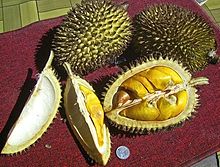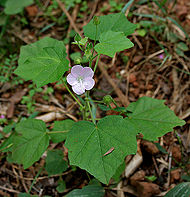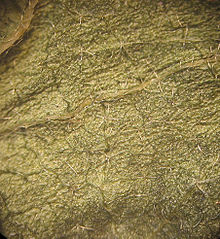- Malvaceae
-
Malvaceae 
Least Mallow, Malva parviflora Scientific classification Kingdom: Plantae (unranked): Angiosperms (unranked): Eudicots (unranked): Rosids Order: Malvales Family: Malvaceae
Juss.Subfamilies Bombacoideae
Brownlowioideae
Byttnerioideae
Dombeyoideae
Grewioideae
Helicteroideae
Malvoideae
Sterculioideae
TilioideaeMalvaceae, or the mallow family, is a family of flowering plants containing over 200 genera with close to 2,300 species.[1] Well known members of this family include okra, jute and cacao. The largest genera in terms of number of species include Hibiscus (300 species), Sterculia (250 species), Dombeya (225 species), Pavonia (200 species) and Sida (200 species[verification needed]).
Contents
Taxonomy
The circumscription of the Malvaceae is very controversial. The traditional Malvaceae sensu stricto comprises a very homogeneous and cladistically monophyletic group. Another major circumscription, Malvaceae sensu lato, has been more recently defined on the basis that molecular techniques have shown that the commonly recognised families Bombacaceae, Tiliaceae, and Sterculiaceae, which have always been considered closely allied to Malvaceae s.s., are not monophyletic groups. Thus the Malvaceae can be been expanded to include all of these families so as to compose a monophyletic group. Adopting this circumscription, Malvaceae incorporates a much larger number of genera.
This article is based on the second circumscription, as presented by the Angiosperm Phylogeny Website.[2] The Malvaceae s.l. (hereafter simply "Malvaceae") comprise nine subfamilies. A tentative cladogram of the family is shown below. The diamond denotes a poorly supported branching (<80%).
Byttnerioideae: 26 genera, 650 species. Pantropical, especially South America
Grewioideae: 25 genera, 770 species. Pantropical.
♦ Sterculioideae: 12 genera, 430 species. Pantropical
Tilioideae: 3 genera, 50 species. Northern temperate regions and Central America
Dombeyoideae: About 20 genera, c.380 species. Palaeotropical, especially Madagascar and Mascarenes
Brownlowioideae: 8 genera, c.70 species. Especially palaeotropical.
Helicteroideae: 8 to 12 genera, 10 to 90 species. Tropical, especially south east Asia.
♦ Malvoideae: 78 genera, 1,670 species. Temperate to tropical.
Bombacoideae: 12 genera, 120 species. Tropical, especially Africa and America
It is important to point out the relationships between these subfamilies are still either poorly supported or almost completely obscure, so that the circumscription of the family may change dramatically as new studies are published.
If looking for information about the traditional Malvaceae s.s., we recommend referring to Malvoideae, the subfamily that approximately corresponds to that group.
Description
Most species are herbs or shrubs but some are trees and lianas.
Leaves and stems
Leaves are generally alternate, often palmately lobed or compound and palmately veined. The margin may be entire, but when dentate a vein ends at the tip of each tooth (malvoid teeth). Stipules are present. The stems contain mucous canals and often also mucous cavities. Hairs are common, and are most typically stellate.
Flowers
The flowers are commonly borne in definite or indefinite axillary inflorescences, which are often reduced to a single flower, but may also be cauliflorous, oppositifolious or terminal. They often bear supernumerary bracts. They can be unisexual or bisexual and are generally actinomorphic, often associated with conspicuous bracts, forming an epicalyx. They generally have five valvate sepals, most frequently basally connate. Five imbricate petals. The stamens are five to numerous, connate at least at their bases, but often forming a tube around the pistils. The pistils are composed of two to many connate carpels. The ovary is superior, with axial placentation. Capitate or lobed stigma. The flowers have nectaries made of many tightly packed glandular hairs, usually positioned on the sepals.
Fruits
 Durian fruits.
Durian fruits.
Most often a loculicidal capsule, a schizocarp or nut.
Pollination
Self pollination is often avoided by means of protandry. Most species are entomophilous (pollinated by insects).
Importance
A number of species are pests in agriculture, including Abutilon theophrasti and Modiola caroliniana, and others that are garden escapes. Cotton (4 species of Gossypium), kenaf (Hibiscus cannabinus), cacao, kola nut and okra (Abelmoschus esculentus) are important agricultural crops. The fruit and leaves of baobabs are edible, as is the fruit of the durian.
References
- Baum, D. A., W. S. Alverson, and R. Nyffeler (1998). "A durian by any other name: taxonomy and nomenclature of the core Malvales". Harvard Papers in Botany 3: 315–330.
- Baum, D. A.; Dewitt Smith, S.; Yen, A.; Alverson, W. S.; Nyffeler, R.; Whitlock, B. A.; Oldham, R. L. (2004). "Phylogenetic relationships of Malvatheca (Bombacoideae and Malvoideae; Malvaceae sensu lato) as inferred from plastid DNA sequences". American Journal of Botany 91 (11): 1863. doi:10.3732/ajb.91.11.1863.
- Bayer, C. (1999). "Support for an expanded family concept of Malvaceae within a recircumscribed order Malvales: a combined analysis of plastidatpB andrbcL DNA sequences". Botanical Journal of the Linnean Society 129 (4): 267–303. doi:10.1006/bojl.1998.0226.
- Bayer, C. and K. Kubitzki 2003. Malvaceae, pp. 225-311. In K. Kubitzki (ed.), The Families and Genera of Vascular Plants, vol. 5, Malvales, Capparales and non-betalain Caryophyllales.
- Edlin, H. L. (1935). "A Critical Revision of Certain Taxonomic Groups of the Malvales Part Ii1". New Phytologist 34 (2): 122. doi:10.1111/j.1469-8137.1935.tb06834.x.
- Judd, W. S.; Manchester, S. R. (1997). "Circumscription of Malvaceae (Malvales) as Determined by a Preliminary Cladistic Analysis of Morphological, Anatomical, Palynological, and Chemical Characters". Brittonia 49 (3): 384–405. doi:10.2307/2807839. JSTOR 2807839.
- Judd, W. S., C. S. Campbell, E. A. Kellogg and P. F. Stevens. Plant Systematics: A Phylogenetic Approach.
- Maas, P. J. M. and L. Y. Th. Westra. 2005. Neotropical Plant Families (3rd edition).
- Perveen, A.; Grafstrom, E.; El-Ghazaly, G. (2004). "World Pollen and Spore Flora 23. Malvaceae Adams. P.p. Subfamilies: Grewioideae, Tilioideae, Brownlowioideae". Grana 43 (3): 129. doi:10.1080/00173130410000730. ISBN 3130410000730.
- Tate, J. A., J. F. Aguilar, S. J. Wagstaff, J. C. La Duke, T. A. Bodo Slotta and B. B. Simpson (2005). "Phylogenetic relationships within the tribe Malveae (Malvaceae, subfamily Malvoideae) as inferred from ITS sequence data". American Journal of Botany 92 (4): 584–602. doi:10.3732/ajb.92.4.584. PMID 21652437. (abstract online here).
See also
Florissantia -- an extinct Cenozoic genus
External links
- Malvaceae in Topwalks
- Alverson, William S., Barbara A. Whitlock, Reto Nyffeler, Clemens Bayer and David A. Baum. 1999. Phylogeny of the core Malvales: evidence from ndhF sequence data. American Journal of Botany 86: 1474-1486.
- Core Malvales from Tree of Life
- Malvaceae: plants of Hawaii (image gallery) from HEAR
- Malvaceae Gallery
- Malvaceae of Mongolia in FloraGREIF
Categories:- Malvaceae
- Malvales families
Wikimedia Foundation. 2010.


